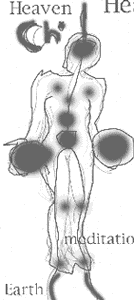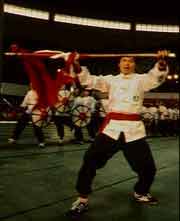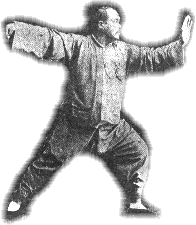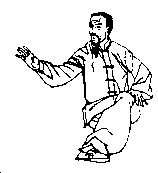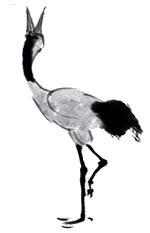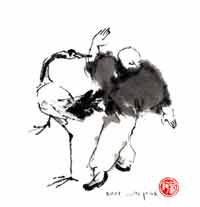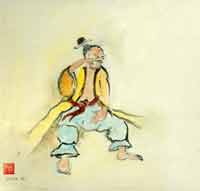Tai Chi History
|
Many
people are fascinated with the mystical taiji (Tai Chi) legend of the
Taoist monk, Zhang Sanfeng, who allegedly invented taijiquan (Tai Chi
Chuan) through dreaming about or observing a fight between a snake and
a crane in Wu-dang Mountains. It's human nature to enjoy and believe
in fairytales. As filmmakers continue to make films with this half-legendary
and half-fictional character, Zhang Sanfeng, based on the stories written
by famous Chinese martial arts novelists such as Jing Yong, I believe
this legend will continue to live for centuries. People always enjoy
passing on this kind of legendary story to future generations like the
legends of King Arthur and Robin Hood. Chen Wangting (1600-1680), a warrior, a scholar, and a ninth generation ancestor of the Chen family, invented Taijiquan after a lifetime of researching, developing, and experiencing martial arts. Chen Changxing (1771-1853), the 14th generation Chen patriarch, was the first to teach Chen Taijiquan to an outsider, Yang Luchan (1799-1872). Vowing to his master to never teach Taijiquan to the public or use its name, Yang was finally taught the Chen family martial art. He later traveled to Beijing and became known as "Yang the Invincible." True to his oath, Yang formulated his own Taijiquan form based on Chen Family Taijiquan's first form (Lao Jia Yi Lu) and became the founder of Yang Taijiquan. Another possible reason for Yang Luchan to formulate his own Taijiquan form might be due to the fact that during those days, the Yang family was employed by the Manchu rulers of the Qing Dynasty to manage the practice and teaching of war. As Manchus were considered the oppressive foreign rulers by the people in their sovereignty (i.e., the Han people), the Yang family probably decided to teach the Manchus only the boxing form, but not the boxing methods nor its applications.
Manchus were taught to be soft as cotton so they would not use Taiji to attack or kill. Direct Yang family members and close disciples, on the other hand, were secretly taught both the hard and soft aspects of Taiji. Yet, the soft form started to gain its popularity and gradually Taiji was recognized and associated with the soft form while people in Chen Village continued to practice both the soft and the hard forms. It's also uncertain when the name "Taijiquan" was given to this Chinese martial arts system. It's very likely that there was no name for Taijiquan when Chen Wangting initially developed this martial arts system because he meant to pass it down to his descendant. It is common for a Chinese family to develop their own style of martial arts. These arts then become known as the style of the family. Chen Wangting didn't know the martial arts system he created would one day become one of the most popular health exercises in the world. The name taijiquan was given later possibly because this unique martial arts system was created based on the principles and theory of Taiji, "Grand Ultimate or Extreme" - yin and yang reaching the ultimate balance and regenerating from each other. Today there are basically two empty-hand Chen Taijiquan forms. The first form is soft and slow, also known as Yi Lu (First Form) whereas the second form is powerful and fast, also known as Er Lu (Second Form) or Pao Chui (Canon Fist). Although a person is not required to be athletic in order to learn Taiji, patience, consistent practice, and time commitment are essential for a Taiji learner to truly benefit from this ancient internal martial arts system. Chen family Taijiquan offers a very complete training system including qigong, empty-hand forms, silk-reeling exercises, push-hand practice, weapon sets, etc. Beginning students usually start with Yi Lu, qigong, and silk-reeling exercises to help them establish a strong foundation and to prepare them if they wish to continue and pursue further the martial aspects of the system. For generations, the practice of Taijiquan has been compromised to the extent that it has lost its original essence. Chen Family Taijiquan, however, has gone through the least amount of change as a martial art and it has not only preserved most of the training methods (e.g., Dan tian rotation exercises, 5 different types of push-hands pattern, etc.) but also some of the most unique training tools (e.g., Taiji bang, Taiji sphere, etc.). It is hoped that through the promotion of Traditional Chen Taijiquan, the public will again recognize Taijiquan not only as a health exercise, benefiting both mental and physical health, but also a truly valuable Chinese martial arts system. |
||
According to statistics, there are over 100 different styles of Chinese boxing alone. "Weaponry" includes nine kinds of long weapons and nine short, such as knives, spears, swords, and clubs, which together constitute what is called the "Eighteen Types of Martial Arts." Each style of boxing and weapon-wielding of "Chinese kung fu" has its own special sequences and movements backed up by comprehensive and profound theories and techniques. Major Tai Chi Chuan Styles
Many Tai Chi styles and variations of styles have been passed down through
the generations. Three styles of Tai Chi Chuan are considered to be
the "major" systems taught throughout the world, although
there are many modified versions. These styles, Chen, Yang, and Wu,
are named after the families that founded them (see Origin & History).
Each of these styles, or systems, has characteristics that make it distinct
from the others, however most of the general principles of Tai Chi Chuan
are the same for all of them (principles of body structure, mind-body
integration, relaxation and breathing, and others, see Introduction
to Tai Chi Chan Principles). |
||
|
|
||
| The primary differences between the three major styles are: 1) Chen contains hard as well as soft techniques, some resembling regular kung fu with fast, hard power and footwork; 2)
Yang is made up of large, graceful circles, and the techniques are easy
to see and understand;
|
||
